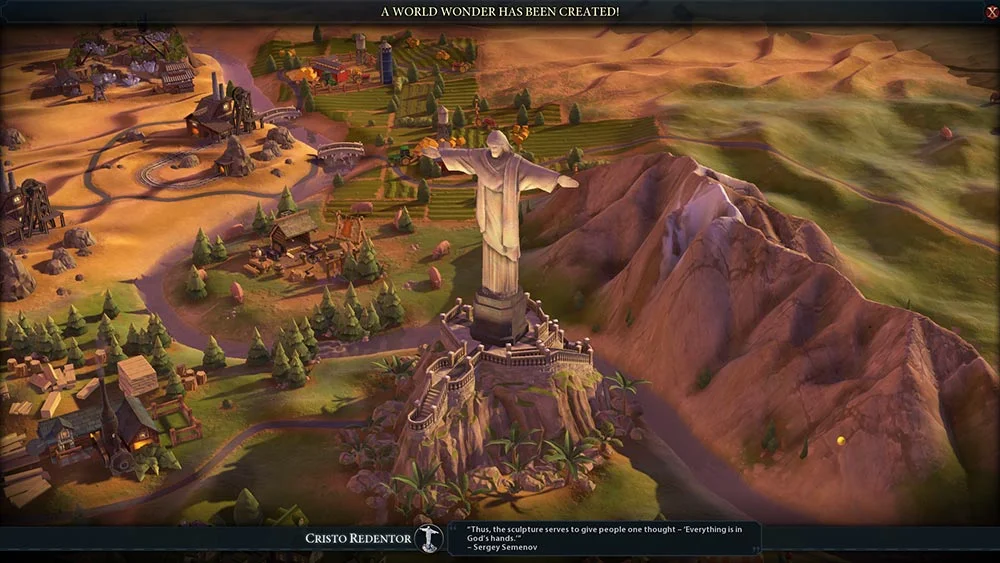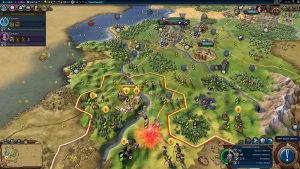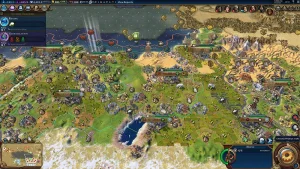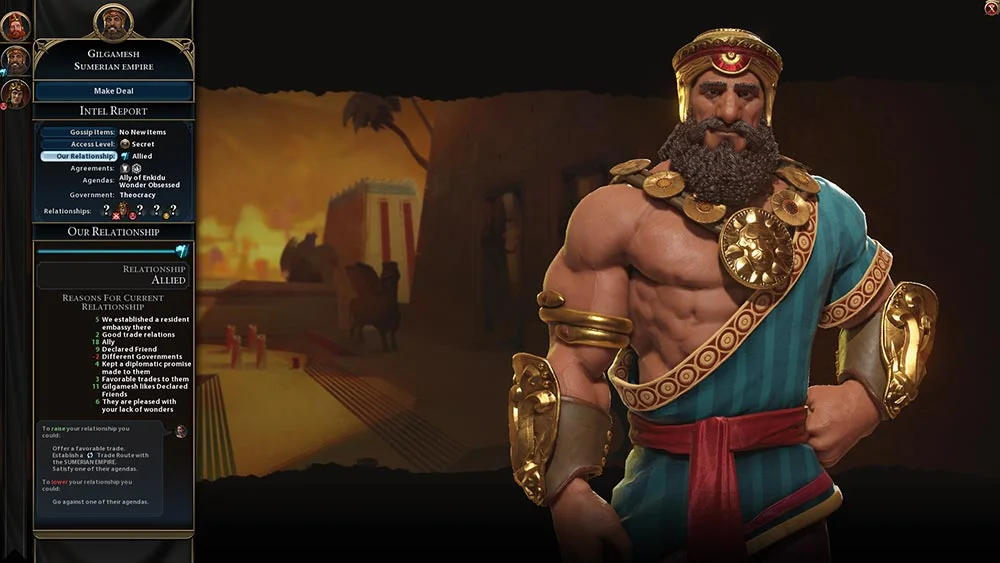Sid Meier’s Civilization VI | Principal Platforms: PC | Developer: Firaxis Games | Publisher: 2K Games | Genre: 4X Strategy | Year: 2016
Housework. If I’m excited for a new video game sequel then that’s what I’ll do the day before; housework. No gorging myself on pre-release news, no staying up until midnight, and no last-minute playthroughs of prequels or the like; just good old-fashioned housework. I cleaned the carpets the day before Halo 2, got the damp off of the walls in time for Dark Souls III, and I’ll probably look at giving the windows a scrub ahead of Pokémon Sun and Moon.
This isn’t just some bizarre ritual to cope with my occasional sequel hype; it’s about chasing perfection and making sure that everything is just right for when you load up that anticipated title screen for the first time. Granted, things didn’t quite pan out in Halo 2’s case, but for a video game series as venerable and respected as Sid Meier’s Civilization; only the best (and tidiest) gaming space will do.
It’s clear that 2K Games has been chasing perfection too. Their “housework” has been to cultivate the perfect storm of Civ VI marketing and community debate in the months leading up to release. The stream-heavy coverage of Civilization VI ensured that pretty much every new feature, playable leader, and unfortunate glitch, was showcased or otherwise spoiled in preview videos and Let’s Plays months in advance. The risk of burnout was pretty high.
So if there are ways in which the game doesn’t feel entirely fresh then those same advertising techniques will partly be to blame, but fortunately Civilization VI is capable of making the biggest impressions all on its own.
The original soundtrack is sublime and returning composer Christopher Tin (of Baba Yetu fame) has outdone himself with another rousing title theme that plays over the main menu. Sogno di Volare (“The Dream of Flight”) sounds as good as it did in concert (yep, I was there!) as well as the opening movie that also introduces the voice talents of Sean Bean who steps in as our celebrity narrator.
It’s a shame that the main menu itself looks so drab and forgettable by comparison. The quality of the graphic design is quite high throughout Civilization VI and yet with such an awesome piece of artwork adorning the game’s box cover and promotional material, it’s difficult to appreciate the boring blue background adorning the main menu. Likewise the leader selection screen is denoted by an unimpressive dropdown featuring tiny icons and a list of difficulty settings that tell you absolutely nothing about what to expect, even missing the most basic tooltip suggesting which levels can be considered easy, normal, or hard.

World Wonders look rather striking during their new animated movies and it’s harder for the AI players to steal them all because of the stricter terrain requirements. Sadly, the Wonders in Civ VI feel a little underwhelming when compared to those from Civ V as most of them are just too expensive or too situational to justify their production cost.
Luckily things start to look a bit brighter when you actually start a game. Civilization VI still presents you with the turn-based affair of governing an entire race of peoples from the Stone Age to the modern era and it’s just as addictive as it’s always been in that regard. As before you will need to tightly manage your empire’s expansion and develop your civilization’s arts, sciences, and diplomatic standings, across randomly seeded maps resembling Earth.
Scouting is still of paramount importance in the early game and it’s a process that’s only been made trickier because of the harsher rules on unit movement. The game doesn’t feel sluggish though; workers now use ‘charges’ to instantly complete tile improvements (as opposed to being placed on a timer) and the more methodical troop movement only contributes to the tactical nature of going to war.
The divide between military classes such as melee, ranged, siege etc. is still clearly visible and yet combat feels a tad more balanced due to each role having more equal importance on the battlefield. Compared to the likes of Beyond Earth, map scripting is pretty good on the whole, so you’ll find ample opportunity for armies to clash without them constantly getting bogged down by bottlenecked terrain. Tile stacking has been improved slightly with vulnerable support units such as battering rams, medics, and even observation balloons, now having the ability to pair up with skirmish units for added protection and reduced tile clutter.
The AI is a bit more capable at warfare. It at least knows how to move and attack with archer class units now and the ever-present barbarian faction will take no prisoners upon discovering your ancient cities. Barbarians are a lethal lot in Civilization VI with their sneaky scouts and relentless horsemen often tearing down your game before it’s even begun. It’s no wonder that recommended build orders start with a warrior!
The AI struggles to handle itself in a full war though. Even at max difficulty an aggressive CPU player can flounder; often flooding a player’s territory with advanced soldiers and cavalry only to have them stand around like potted plants instead of actively pillaging or taking cities. I’ve already beaten Civilization VI three times at Deity level – that should read “hardest” difficulty there, Firaxis – with one attempt featuring superior opponents who hated my guts and yet seemed completely unwilling to do anything about it for the entire duration of the game. A lot of this talk regarding poor AI is familiar territory of course so it’s gratifying that Civilization VI introduces major changes in other areas.

Ranged units don’t rule the battlefield like they used to. Melee and siege units are more important for putting enemy cities under pressure.
The new city system is a big one that allows districts and wonders to sprawl out onto city hexes instead of just being confined to a menu. Districts come in many flavours whether they be military encampments and pious holy sites, or yield-enhancing commercial hubs and industrial zones. Each district provides a space for several unique buildings and knowing where best to place these sites is absolutely crucial to your long-term success. Not only do districts benefit from adjacency bonuses, but they can also transmit their yields to other cities within a certain tile radius. If you build a factory in your industrial zone for instance, then its production bonus can potentially apply to every other city in your empire if they’re close enough together. It’s an interesting system in some ways as it really gets you thinking about cities way before they’re actually settled and the concept turns the whole founding process into a delightful puzzle that rearranges itself from game to game.
The acquisition of science and culture is refreshingly downplayed amid all of this due to the addition of Inspirations and Eurekas. These contextual bonuses to technologies and civic policies unlock when you perform a specific action or group of actions in-game. Settle a city near the coast for example and your knowledge of sailing will preemptively increase as your citizens dream of a life taming the nearby ocean. Similarly, if you make a good start spreading a religion you founded, then the culture tree will receive a lump sum of free progress towards the Reformed Church civic that will strengthen your powers of faith even further.
Inspirations and Eurekas are remarkably potent in that they provide 50% (or 60% in China’s case) of the prerequisite science or culture for a given project. Whereas before you would simply watch research timers count down, here in Civilization VI you are constantly working towards that next freebie by building units, harvesting resources, and cultivating your sovereign turf. It’s more engaging to be sure.
There are times where you’ll collect Inspirations without really thinking about them though and at the moment there’s not much to distinguish civics from being yet another tree of unlocks and culture merely as a form of “purple science”, but the advantages that these systems bring will at least encourage different styles of play between games and help curb the common syndrome of players clicking ‘next turn’ over and over again.
A good job has been done with regards to the playable leaders. Much fuss has been made here about Civilization’s return to a more stylized or “cartooney” art style, but the Pixar-like quality in the leaders’ facial expressions, voice acting, and body language, makes them a delight to talk to again and again. My favourite is Phillip II of Spain, whose barely contained anger towards you when he’s hostile, is matched only by his ridiculously smug grin upon him turning friendly. If Civilization VI can be said to have really nailed anything, then it’s definitely the leaders!
There are civilizations that feel better than others from a gameplay perspective (Germany seems extremely powerful in the current production-hungry meta), but the match-ups feel reasonably considered at the moment with only the likes of Spain, Norway, and maybe France, feeling a bit lacklustre when compared to the rest. No doubt this balancing act will get easier once a few patches are released, but for now it’s not a bad lineup of play styles all things considered.

The happiness system in Civ VI is quite lenient and allows players to once again maintain sprawling empires full of cities.
Talk of software patches is clearly a hot topic though because for everything Civilization VI gets right there is a counterpoint that threatens to overshadow everything else that’s good about it.
The current state of the game seems sharply orientated around city production, meaning that players are expected to keep up with rapidly escalating build and purchase costs as the in-game years roll by. Failure to adequately tune your districts can leave you in a situation where building anything in a city takes a very long time to complete. The scientific victory condition, whereby players are tasked with launching a satellite and ultimately a space shuttle in order to win, is incredibly drawn-out if you’re not experienced with how proper district construction works.
The new religious victory can also get quite tedious as most of the major policies you’ll need will dry up in the mid game. If you pursue a purely religious path then half of the game’s new features will be utterly useless as you give yourself over to spamming missionaries and apostles as fast as you can in the name of some remarkably cheap win times. Even worse is the almost complete lack of displayed data for things like religious pressure and conversion; key systems that a player pursuing this victory needs to know about.
And so too does the cultural victory seem wonky. Like Civilization V the goal is to produce enough tourism to attract your opponent’s visiting citizens, but it’s all so poorly explained that you won’t really know what you’re doing even after reading the documentation a dozen times. I gathered that national parks were crucial to achieving a cultural win in my one game, but I quickly became perplexed by the lack of information on what these parks actually did or where they could be constructed. In the end all these so-called tile “improvements” did was change a white line around a mountain in my territory into a green line! It made absolutely no sense thematically and I had to take the game’s word for it that the parks even did anything at all.
It’s a shame that Firaxis chose to ditch the concept of a diplomatic victory considering their newly refined diplomacy system. Whilst far from perfect, there is some hidden depth in maintaining a friendly relationship with an AI-controlled player. Gaining a rival leader’s trust and forming a lasting alliance takes a lot of time and patience with many of your interactions with them prompting modifiers that affect their opinion of you.
Everything from trade deals, army sizes, and even non-binding promises can have an impact on an AI’s attitude and it’s only at the higher levels of trust that you’ll be able to establish the embassies which reveal what that civilization is currently plotting.

Leaders have two personality traits that govern their strategy and demeanour. The first trait is specific to the individual (Gilgamesh here always has major respect for his allies) whereas the second trait is randomly drawn from a pool to make that leader more unpredictable from game to game. It’s a great system and yes, it’s entirely possible to meet a ‘Nuke Happy’ Ghandi.
The AI personalty traits are a good idea, and yet certain leaders possess agendas so broad that it can be almost impossible to satisfy them because of how strongly those agendas are valued in the diplomatic arena. For instance, Pericles and Frederick Barbarossa both enjoy fostering compliance with city states and they’ll dislike anyone else who does the same. City states now work on a binary system whereby cooperating players send diplomatic envoys (via a glorified checkbox) or by completing requests that generate an envoy automatically.
This automatic generation is just that; automatic. You can easily acquire envoys here without even meaning to which makes maintaining favour with Pericles or Frederick extremely difficult as they’ll completely lose their minds should you so much as strike up a conversation with their beloved city state shills.
Espionage is a closely linked system in some ways as once you’ve trained a spy you’ll find plenty more ways in which you can deal or otherwise screw with the AI leaders around you. The implementation of espionage is a bit fiddly at the moment, but it has to be said that stealing a rival civilization’s great works of art is very satisfying, as is giving your spies unique promotions and ransoming captured operatives back to their original owners!
Many of these refinements betray Lead Designer, Ed Beach’s fondness for more “boardgamey” mechanics. The returning governments system is especially indicative of this with its various innate bonuses and card slots that allow you to upgrade your empire depending on the policy cards you have collected from researching technologies and civics. Even though several cards here feel like no-brainers at the moment (and a nightmare to sort through at that), it still makes for an engrossing system and it’s one that creates plenty of diverse and flexible synergies for players to mess around with.
The fact that Civilization VI packs in all these major gameplay elements (tourism, spying, religion etc.) from Civilization V and its various expansions is nothing short of commendable. Little has been lost in the translation to a more streamlined and less demanding world-building experience, but the real disappointment comes from how opaque and poorly explained a lot of this streamlining actually is.

The fog of war that’s represented by an unfolding parchment map is rather beautiful, but it’s also very “busy” and can look confusing at times.
Arguably the biggest problem with Civ VI right now is the dodgy UI design which prompts more confused questions per minute than perhaps any area of the entire game. Why can’t I click a city name to access city management? What did my scout just pick up from that tribal village? Why don’t map settings and yield icons save between games? And why is that city bombard crosshair so friggin’ small!?
The way that unit icons fade when they fortify gives the false impression that they can’t move, there are no details given on when a city’s cultural borders will expand, and many tooltips fail to tell you anything useful at all. Tooltips for tile improvements often don’t take into account your acquired bonuses for instance and when I hovered over the icon for the Hermitage I was informed “must be built on a river” instead of what made that wonder, er… wonderful.
The iconography is also underwhelming. Gone are Civilization V’s gorgeous little resource bubbles; now replaced by generic icons that look… odd. Cattle are represented by a jug of milk which is fairly abstract as well as lame, the horses look like donkeys, the fish look like whales, and the sheep are almost indiscernible at a glance. The unit icons fare no better; once again ditching the detailed artwork for all-white symbols in the mold of Beyond Earth’s flavourless UI.
It might not be so bad if the in-game encyclopedia – which is intended to be a primer for the game’s inner-workings by the way – wasn’t so incomplete and poorly laid out. The explanation of important game concepts in the “Civlopedia” can be extremely vague and it’s more awkward to access than Civ V’s handy ‘right-click just about anything for info’ style of interface and it doesn’t even feature on the main menu anymore. The search feature is dodgy (not even recognizing the query “spy”), there is no detailed information on how corps, fleets, or naturalists work, and there’s absolutely no detail given on nuclear weapons whatsoever.
It’s aggravating because elsewhere the presentation is really good. Sean Bean’s dulcet tones are a nice fit for the many narrated quotes, loading times are faster than Civ V on average, and there are plenty of little touches to be happy about. The seamless natural wonder reveals are pretty sweet, as is the CPU benchmarking feature, and there’s even a clock!
Indeed, the game is in a pretty good state in terms of build quality, but there are still plenty of annoying bugs that spoil the experience. Trading with the AI is wildly inconsistent for one and there are some concerning exploits at the moment including a hard-to-avoid error with overflow values and the now infamous “Sythian horse market” that allows players to generate lucrative amounts of gold by selling cheap mules.
And in spite of its attractive art style, Civilization VI wildly varies where matters of tone are concerned. The stylised leaders and ethnic character models are suitable additions, but things like the worker repair and religious “combat” animations are like something you’d see in a Looney Tunes episode. Many of the more historical quotes on the tech tree are accompanied by “bits” taken from Western comedians, and revealing Mt. Kilimanjaro prompts an insipid soundbite about Wi-Fi connectivity that, aside from being totally immersion-breaking, just feels out of place and too desperate to be funny.

City states now give their allies unique bonuses. Some are just dull yields, but others, like these bizarre stone head improvements, are more fun!
All of the key gameplay elements are in place, and yet there are several curious omissions like the missing Hall of Fame, the missing restart option, and the tremendously annoying absence of the city build queue. Then you have the broken team options for multiplayer mode which, according to information uncovered by the community, have been temporarily disabled in the release version due to several game-breaking problems. The fact that the community had to uncover this major failing in a AAA product without any advance warning is absolutely appalling and it doesn’t speak well of the communication between 2K Games and their customers at all.
It’s clear that everything needs to be made much more transparent across the board and until such problems are addressed, it’s going to be hard to get excited about Civ VI past a few exploratory sessions.
At the moment Civ VI is an OK game. Civilization V had teething problems too and in comparison Civilization VI represents a solid start and is certainly a worthy sequel overall. But it needs time and it needs work. Preferably a lot of both.
The leap between Civ V and Civ VI is much shorter than the gaping chasm that separated Civ IV and Civ V, but even if Civilization VI is an incremental upgrade in this sense, it does still have potential to be an amazing video game in its own right. Its longterm success rests on Firaxis’ ability to respond to community feedback in a way they clearly couldn’t do with their spin-offs.
Rome wasn’t built in a day and neither will Civilization VI. At the moment what’s here shows a lot of promise, but just be warned that it also requires a lot of patience.


Leave A Comment